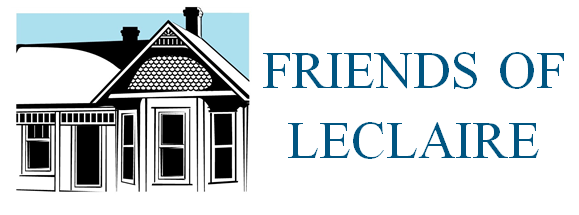The Friends of Leclaire Newsletter was awarded a Certificate of Merit by the Illinois State Historical Society at their Best of Illinois History celebration held via Zoom on April 23. A quarterly publication, the newsletter has been published by the Friends of Leclaire (FOL) since 1990.
The newsletter was founded by Dr. Robert Blain when the Friends of Leclaire organization was created following a centennial celebration for the former Village of Leclaire. The purpose of the newsletter was to build awareness of organization activities and to inform residents of the history of the Leclaire National Historic District. In the early years it was one sheet of paper with content on both sides, but soon grew to be a four-page newsletter with additional stories of Leclaire. In the late 1990s, Cindy Reinhardt began writing articles for the newsletter and in 2009 when a new layout made it easier to write and edit at the same time, Reinhardt became editor. The newsletter typically has two pages of FOL news followed by two pages of articles about Leclaire history. Most issues feature of one of Leclaire’s historic homes, telling the story of when it was built and the families who first occupied the house.
The newsletter is still hand-delivered to every home in Leclaire by volunteers, whether the resident is a member of the organization or not. The organization’s name, suggested by Jim Fralinger, was “Friends” of Leclaire because there are so many members who no longer live in Leclaire, but have an affinity for the neighborhood. Many grew up in the neighborhood. Friends of Leclaire has approximately 75 persons on their mailing list who do not live in Leclaire but choose to be members of the organization. Memberships, open to everyone, are $20 annually.
Leclaire was founded in 1890 as an experiment in cooperative living by St. Louis Manufacturer, N. O. Nelson who was looking for a way to improve the lives of his workers. Victorian cottages with electric lights and running water were build in the residential area which now has over 400 homes. Unlike other factory towns, home ownership was encouraged and supported by the company.
The Leclaire campus included a school building that provided educational opportunities for both children and adults and also served as a social hall for concerts and dances. Today, it is home to the Children’s Museum at Edwardsville. The recreational complex next to the school had a bowling hall, baseball fields, tennis courts and, before 1924, a football field used by the Leclaire Tigers who became the Edwardsville High School Tigers. In addition, Leclaire Lake provided opportunities for swimming, picnics, boating and, in the winter, skating.
Leclaire’s innovative factory buildings, once called “the ideal perfection for many to labor in” by famous reporter Nellie Bly, are now the home of the Historic N. O. Nelson Campus of Lewis and Clark Community College. Workers at the N. O. Nelson Manufacturing Company were paid a fair wage, given reasonable hours and in case of accident or illness, were paid through a company Provinant Fund. Another important benefit was profit-sharing.
The “Leclaire experiment” as it was often called, was known throughout the United States and Europe. In 1934, Leclaire needed a new sewer system that they could not afford, so residents voted to annex to the city of Edwardsville. It was no longer Edwardsville’s “suburb to the south.”
Today, residents of Leclaire, thanks to the Friends of Leclaire newsletter, are aware that they live in a special neighborhood. The June edition of the newsletter will be a history of the Nickel Plate Station which was one of the reasons that N. O. Nelson chose to build his experimental village on land just south of Edwardsville in 1890. The 1883 station was recently restored by the City of Edwardsville.
